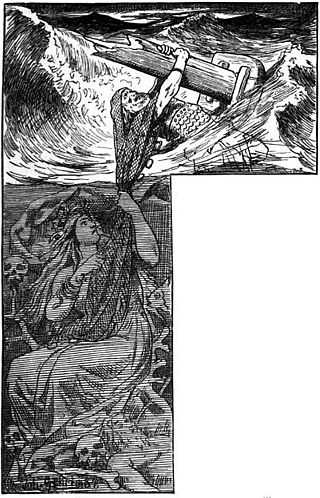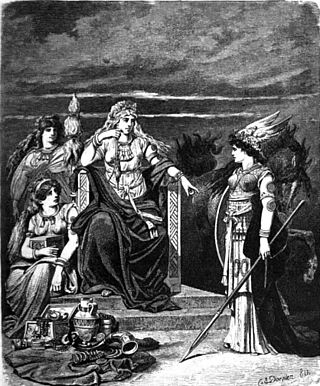Related Research Articles

In Norse mythology, Rán is a goddess and a personification of the sea. Rán and her husband Ægir, a jötunn who also personifies the sea, have nine daughters, who personify waves. The goddess is frequently associated with a net, which she uses to capture sea-goers. According to the prose introduction to a poem in the Poetic Edda and in Völsunga saga, Rán once loaned her net to the god Loki.

Sigyn is a deity from Norse mythology. She is attested in the Poetic Edda, compiled in the 13th century from earlier traditional sources, and the Prose Edda, written in the 13th century by Snorri Sturluson. In the Poetic Edda, little information is provided about Sigyn other than her role in assisting her husband Loki during his captivity. In the Prose Edda, her role in helping Loki through his time spent in bondage is reiterated, she appears in various kennings, and her status as a goddess is mentioned twice. Sigyn may appear on the Gosforth Cross and has been the subject of an amount of theory and cultural references.

Fulla or Volla is a goddess in Germanic mythology. In Norse mythology, Fulla is described as wearing a golden band and as tending to the ashen box and the footwear owned by the goddess Frigg, and, in addition, Frigg confides in Fulla her secrets. Fulla is attested in the Poetic Edda, compiled in the 13th century from earlier traditional sources; the Prose Edda, written in the 13th century by Snorri Sturluson; and in skaldic poetry. Volla (Folla) is attested in the "Horse Cure" Merseburg Incantation, recorded anonymously in the 10th century in Old High German, in which she assists in healing the wounded foal of Phol and is referred to as Frigg's sister. Scholars have proposed theories about the implications of the goddess.

In Norse mythology, Gná is a goddess who runs errands in other worlds for the goddess Frigg and rides the flying, sea-treading horse Hófvarpnir. Gná and Hófvarpnir are attested in the Prose Edda, written in the 13th century by Snorri Sturluson. Scholarly theories have been proposed about Gná as a "goddess of fullness" and as potentially cognate to Fama from Roman mythology. Hófvarpnir and the eight-legged steed Sleipnir have been cited examples of transcendent horses in Norse mythology.

In Norse mythology, Hlín is a goddess associated with the goddess Frigg. Hlín appears in a poem in the Poetic Edda, compiled in the 13th century from earlier traditional sources, the Prose Edda, written in the 13th century by Snorri Sturluson, and in kennings found in skaldic poetry. Scholars have debated whether the stanza referring to her in the Prose Edda refers to Frigg. Hlín serves as a given name in Iceland, and Hlín receives veneration in the modern era in Germanic paganism's modern extension, Heathenry.

In Norse mythology, Eir is a goddess or valkyrie associated with medical skill. Eir is attested in the Poetic Edda, compiled in the 13th century from earlier traditional sources; the Prose Edda, written in the 13th century by Snorri Sturluson; and in skaldic poetry, including a runic inscription from Bergen, Norway from around 1300. Scholars have theorized about whether these three sources refer to the same figure, and debate whether Eir may have been originally a healing goddess or a valkyrie. In addition, Eir has been compared to the Greek goddess Hygieia.
In Norse mythology, Snotra is a goddess associated with wisdom. Snotra is attested in the Prose Edda, written in the 13th century by Snorri Sturluson, and in the Gautreks Saga, where she is the mother of Gautrek son of Gauti, the eponymous ancestor of the Geats, and Goths, a son of Oðinn as King of Sviþjoð. Scholars have proposed theories about the implications of the goddess.
In Norse mythology, Vör is a goddess associated with wisdom. Vör is attested in the Prose Edda, written in the 13th century by Snorri Sturluson; and twice in kennings employed in skaldic poetry. Scholars have proposed theories about the implications of the goddess.
In Norse mythology, Vár or Vór is a goddess associated with oaths and agreements. Vár is attested in the Poetic Edda, compiled in the 13th century from earlier traditional sources; the Prose Edda, written in the 13th century by Snorri Sturluson; and kennings found in skaldic poetry and a runic inscription. Scholars have proposed theories about the implications of the goddess.
In Norse mythology, Sessrúmnir is both the goddess Freyja's hall located in Fólkvangr, a field where Freyja receives half of those who die in battle, and also the name of a ship. Both the hall and the ship are attested in the Prose Edda, written in the 13th century by Snorri Sturluson. Scholarly theories have been proposed regarding a potential relation between the hall and the ship.

In Norse mythology, Fensalir is a location where the goddess Frigg dwells. Fensalir is attested in the Poetic Edda, compiled in the 13th century from earlier traditional sources, and the Prose Edda, written in the 13th century by Snorri Sturluson. Scholars have proposed theories about the implications of the location, including that the location may have some connection to religious practices involving springs, bogs, or swamps in Norse paganism, and that it may be connected to the goddess Sága's watery location Sökkvabekkr.
In Norse mythology, Lofn is a goddess. Lofn is attested in the Prose Edda, written in the 13th century by Snorri Sturluson and in kennings found in skaldic poetry. In the Prose Edda, Lofn is described as gentle in manner and as an arranger of marriages, even when they have been forbidden. Scholars have proposed theories about the implications of the goddess.
Járnsaxa is a jötunn in Norse mythology. In Snorri Sturluson's Prose Edda, she is portrayed as Thor's lover and as the mother of Magni, a three-year-old boy with prodigious force.

In Norse mythology, Óðr or Óð, sometimes anglicized as Odr or Od, is a figure associated with the major goddess Freyja. The Prose Edda and Heimskringla, written in the 13th century by Snorri Sturluson, both describe Óðr as Freyja's husband and father of her daughter Hnoss. Heimskringla adds that the couple produced another daughter, Gersemi. A number of theories have been proposed about Óðr, generally that he is a hypostasis of the deity Odin due to their similarities.

Máni is the Moon personified in Germanic mythology. Máni, personified, is attested in the Poetic Edda, compiled in the 13th century from earlier traditional sources, and the Prose Edda, written in the 13th century by Snorri Sturluson. Both sources state that he is the brother of the personified sun, Sól, and the son of Mundilfari, while the Prose Edda adds that he is followed by the children Hjúki and Bil through the heavens. As a proper noun, Máni appears throughout Old Norse literature. Scholars have proposed theories about Máni's potential connection to the Northern European notion of the Man in the Moon, and a potentially otherwise unattested story regarding Máni through skaldic kennings.
In Norse cosmology, svartálfar, also called myrkálfar, are beings who dwell in Svartalfheim. Both the svartálfar and Svartálfaheimr are primarily attested in the Prose Edda, written in the 13th century by Snorri Sturluson. Scholars have noted that the svartálfar appear to be synonymous with the dwarfs and potentially also the dökkálfar. As dwarfs, the home of the svartálfar could possibly be another description for Niðavellir.
In Norse mythology, Sjöfn is a goddess associated with love. Sjöfn is attested in the Prose Edda, written in the 13th century by Snorri Sturluson; and in three kennings employed in skaldic poetry. Scholars have proposed theories about the implications of the goddess.
In Norse mythology, Auðr is the son of the personified night, Nótt, fathered by Naglfari, and uncle of Thor. Auðr is attested in the Prose Edda, written in the 13th century by Snorri Sturluson, and in the poetry of skalds.

In Norse mythology, Sága is a goddess associated with the location Sökkvabekkr. At Sökkvabekkr, Sága and the god Odin merrily drink as cool waves flow. Both Sága and Sökkvabekkr are attested in the Poetic Edda, compiled in the 13th century from earlier traditional sources, and in the Prose Edda, written in the 13th century by Snorri Sturluson. Scholars have proposed theories about the implications of the goddess and her associated location, including that the location may be connected to the goddess Frigg's fen residence Fensalir and that Sága may be another name for Frigg.

In Norse mythology, Hjúki and Bil are a brother and sister pair of children who follow the personified Moon, Máni, across the heavens. Both Hjúki and Bil are solely attested in the Prose Edda, written in the 13th century by Snorri Sturluson. Scholarly theories that surround the two concern their nature, their role as potential personifications of the craters on the Moon or its phases, and their relation to later folklore in Germanic Europe. Bil has been identified with the Bilwis, an agriculture-associated figure that is frequently attested in the folklore of German-speaking areas of Europe.
References
- Faulkes, Anthony (Trans.) (1995). Snorri Sturluson: Edda. First published in 1987. London: Everyman. ISBN 0-460-87616-3
- Orchard, Andy (1997). Dictionary of Norse Myth and Legend. Cassell. ISBN 0-304-34520-2
- Simek, Rudolf (2007) translated by Angela Hall. Dictionary of Northern Mythology. D.S. Brewer. ISBN 0-85991-513-1